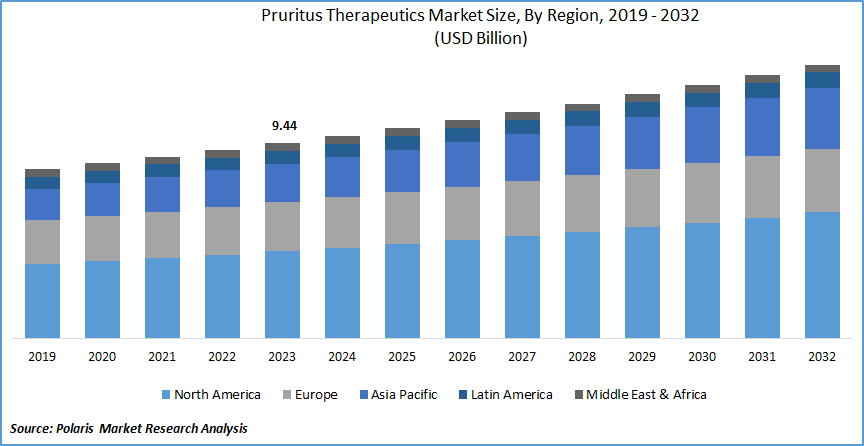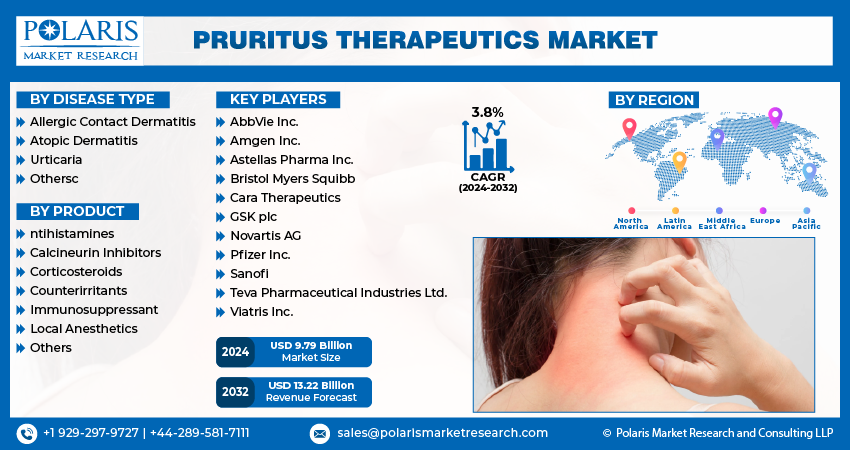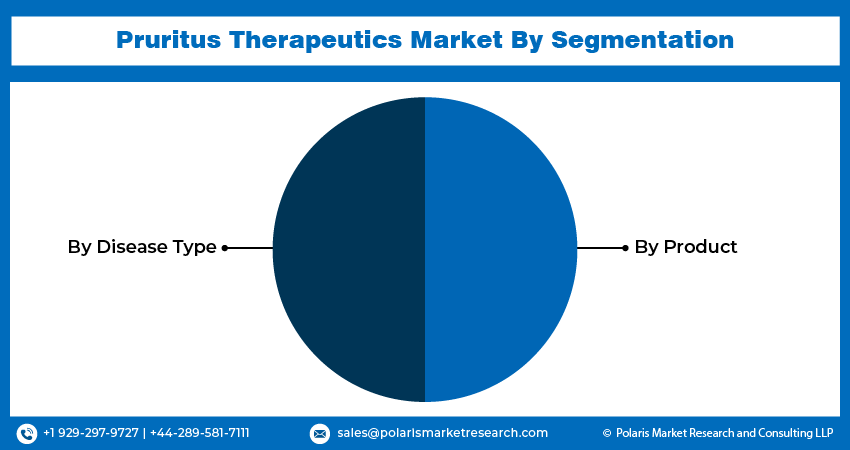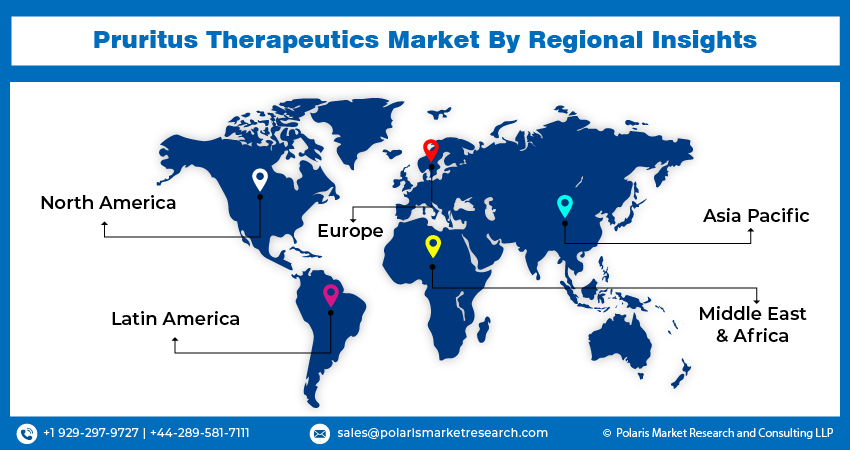
Pruritus Therapeutics Market Share, Size, Trends, Industry Analysis Report, By Disease Type (Allergic Contact Dermatitis, Atopic Dermatitis, Urticaria, Others); By Product; By Region; Segment Forecast, 2024 - 2032
- Published Date:Jun-2024
- Pages: 120
- Format: PDF
- Report ID: PM1301
- Base Year: 2023
- Historical Data: 2019-2022
Report Outlook
Pruritus Therapeutics Market size was valued at USD 9.44 billion in 2023. The market is anticipated to grow from USD 9.79 billion in 2024 to USD 13.22 billion by 2032, exhibiting the CAGR of 3.8% during the forecast period.
Industry Trends
Pruritus therapeutics refers to the range of treatments and interventions designed to alleviate pruritus, which is the medical term for chronic itching. Pruritus can be a symptom of various underlying conditions, including dermatological diseases like eczema and psoriasis, systemic disorders such as chronic kidney disease or liver disease, allergies, and even certain cancers.

To Understand More About this Research:Request a Free Sample Report
The pruritus therapeutics market is experiencing notable growth due to the increasing prevalence of chronic pruritus associated with various dermatological and systemic conditions. The rising awareness of the significant impact of pruritus on patients' quality of life is driving the demand for effective treatment options. Innovations in pharmaceuticals, particularly the development of novel biologics and targeted therapies, are expanding the arsenal of treatments available for pruritus, leading to improved patient outcomes. Also, the aging global population, which is more susceptible to conditions causing chronic itching, is further fueling the market growth.
The key market trends in the market include the development and adoption of biologic drugs and immunomodulators that specifically target the molecular mechanisms underlying pruritus. The integration of advanced drug delivery systems to enhance the efficacy and compliance of topical treatments is also gaining traction. Moreover, there is an increasing focus on personalized medicine, where treatments are tailored to the individual patient's condition and response to therapy. The market is witnessing collaborations between pharmaceutical companies and research institutions to accelerate the development of innovative therapies. Digital health technologies, including telemedicine and mobile health apps, are emerging as supportive tools in the management of pruritus, providing patients with easier access to healthcare professionals and treatment plans.
Despite the positive growth outlook, the market is hampered by the high cost of advanced treatments, particularly biologics, and novel therapies, which slim their accessibility and adoption, especially in developing regions with constrained healthcare budgets.
Key Takeaways
- North America dominated the market and contributed over 36% market share of the pruritus therapeutics market size in 2023
- By disease type category, the atopic dermatitis segment dominated the global pruritus therapeutics market size in 2023
- By product category, the corticosteroids segment held the dominant revenue share in 2023
What are the Market Drivers Driving the Demand for Market?
Increasing Prevalence of Dermatological Conditions
The increasing prevalence of dermatological conditions is a significant driving factor for the pruritus therapeutics market. These skin disorders are often accompanied by chronic itching or pruritus, which can severely impact patients' quality of life. Conditions such as eczema, psoriasis, atopic dermatitis, and other inflammatory skin diseases are becoming more common globally due to factors such as urbanization, pollution, and changing lifestyles that contribute to skin barrier dysfunction and immune system alterations. As the incidence of these conditions rises, so does the demand for effective treatments to manage their symptoms, particularly pruritus. This growing patient population creates a substantial need for advanced pruritus therapeutics that can provide relief from itching, improve skin health, and enhance overall well-being.
Thus, pharmaceutical companies are increasingly focusing on developing and marketing new and innovative treatments specifically designed to target the underlying causes of pruritus associated with these dermatological conditions, thereby driving the market forward.
Which Factor is Restraining the Demand for Pruritus Therapeutics?
Adverse Effects and Safety Concerns
Adverse effects and safety concerns are significant restraining factors for the pruritus therapeutics market because they limit the widespread adoption and acceptance of certain treatments. Many therapies used to manage pruritus, especially those involving systemic medications like immunosuppressants and biologics, can cause a range of side effects, from mild to severe. These adverse effects include immune suppression, increased susceptibility to infections, liver or kidney damage, and other systemic complications. Also, the occurrence of adverse effects can lead to discontinuation of treatment, reducing its overall effectiveness and patient compliance. This hesitation hampers market growth as developing safer and more tolerable treatments becomes a complex and costly process for pharmaceutical companies.

Report Segmentation
The market is primarily segmented based on disease type, product, and region.
|
By Disease Type |
By Product |
By Region |
|
|
|
To Understand the Scope of this Report:Speak to Analyst
Category Wise Insights
By Disease Type Insights
Based on disease type category analysis, the market has been segmented on the basis of allergic contact dermatitis, atopic dermatitis, urticaria, and others. The atopic dermatitis segment dominated the global pruritus therapeutics market size in 2023 due to the high prevalence and chronic nature of the condition, which often includes severe and persistent itching as a primary symptom. Atopic dermatitis affects a significant portion of the population, including both children and adults, leading to a substantial demand for effective pruritus management. The complexity and chronicity of atopic dermatitis necessitate ongoing treatment, driving continuous demand for therapeutic interventions.
Also, advancements in the understanding of the immunological and genetic underpinnings of atopic dermatitis have spurred the development of targeted therapies, including new biologics and other innovative treatments specifically designed to alleviate pruritus. These treatments offer improved efficacy and safety profiles, encouraging both healthcare providers and patients to adopt them more widely.
By Product Insights
Based on product category analysis, the market has been segmented on the basis of antihistamines, calcineurin inhibitors, corticosteroids, counterirritants, immunosuppressant, local anesthetics, and others. The corticosteroids segment held the dominant revenue share in the global pruritus therapeutics market in 2023 due to their widespread use and proven efficacy in managing a variety of inflammatory skin conditions that cause pruritus. Corticosteroids are commonly prescribed as first-line treatments for conditions such as eczema, psoriasis, and atopic dermatitis because they effectively reduce inflammation and itching. Their versatility in being available in multiple formulations and systemic forms allows for tailored treatment approaches depending on the severity and location of the condition.
Also, corticosteroids have been well-established in clinical practice for decades, fostering a high level of trust and familiarity among healthcare providers and patients alike. Despite the potential for side effects with long-term use, their rapid relief of symptoms and cost-effectiveness make them a mainstay in pruritus management, thereby driving significant revenue in the pruritus therapeutics market.

Regional Insights
North America
In 2023, North America emerged as the dominant region in the global pruritus therapeutics market since the region has a high prevalence of dermatological conditions such as atopic dermatitis, psoriasis, and eczema, which significantly drive the demand for pruritus treatments. North America's advanced healthcare infrastructure, substantial healthcare expenditure, and extensive insurance coverage facilitate widespread access to both established and innovative therapeutic options. The region is also home to leading pharmaceutical companies and research institutions that are at the forefront of developing new and effective pruritus therapies, including biologics and targeted treatments.
Asia Pacific
The Asia Pacific region is anticipated to grow substantially in the pruritus therapeutics market due to a combination of factors, including increasing prevalence of dermatological conditions, improving healthcare infrastructure, and rising awareness about the impact of chronic pruritus on quality of life. Rapid urbanization and industrialization in countries such as China, India, and Japan are contributing to higher incidences of skin disorders like eczema and psoriasis, which drive the demand for effective pruritus treatments. Also, economic growth in the region is leading to increased healthcare spending and greater access to advanced medical therapies.

Competitive Landscape
The competitive landscape for the pruritus therapeutics market is marked by intense rivalry among several key pharmaceutical companies and emerging biotech firms focused on developing innovative treatments for chronic itching. Major players are leading the market with a robust pipeline of advanced biologics, immunomodulators, and other targeted therapies that address the underlying causes of pruritus. These companies invest heavily in research and development to bring new and more effective therapies to market, often through strategic partnerships, collaborations, and acquisitions.
Some of the major players operating in the global market include:
- AbbVie Inc.
- Amgen Inc.
- Astellas Pharma Inc.
- Bristol Myers Squibb
- Cara Therapeutics
- GSK plc
- Novartis AG
- Pfizer Inc.
- Sanofi
- Teva Pharmaceutical Industries Ltd.
- Viatris Inc.
Recent Developments
- In September 2023, Cara Therapeutics, Inc., a company specializing in biopharmaceuticals, announced that its licensing partner, Maruishi Pharmaceutical Co., Ltd., has received approval from Japan's Ministry of Health, Labour and Welfare for the manufacturing and marketing of KORSUVA IV Injection Syringe. This approval is for the treatment of pruritus in hemodialysis patients, marking a significant advancement in addressing this condition.
- In February 2024, Galderma has announced that the U.S. Food and Drug Administration (FDA) has accepted its Biologics License Applications for nemolizumab. This application is for the treatment of prurigo nodularis and adolescents and adults with moderate to severe atopic dermatitis.
- In November 2020, Kiniksa Pharmaceuticals, Ltd., a biopharmaceutical company focused on developing assets to regulate immunological pathways for various diseases, has announced that the U.S. Food and Drug Administration (FDA) has granted vixarelimab Breakthrough Therapy designation for treating pruritus associated with prurigo nodularis.
Report Coverage
The pruritus therapeutics market report emphasizes on key regions across the globe to provide better understanding of the product to the users. Also, the report provides market insights into recent developments, trends and analyzes the technologies that are gaining traction around the globe. Furthermore, the report covers in-depth qualitative analysis pertaining to various paradigm shifts associated with the transformation of these solutions.
The report provides detailed analysis of the market while focusing on various key aspects such as competitive analysis, disease type, product, and their futuristic growth opportunities.
Pruritus Therapeutics Market Report Scope
|
Report Attributes |
Details |
|
Market size value in 2024 |
USD 9.79 billion |
|
Revenue forecast in 2032 |
USD 13.22 billion |
|
CAGR |
3.8% from 2024 – 2032 |
|
Base year |
2023 |
|
Historical data |
2019 – 2022 |
|
Forecast period |
2024 – 2032 |
|
Quantitative units |
Revenue in USD billion and CAGR from 2024 to 2032 |
|
Segments covered |
By Disease Type, By Product, By Region |
|
Regional scope |
North America, Europe, Asia Pacific, Latin America, Middle East & Africa |
|
Customization |
Report customization as per your requirements with respect to countries, region and segmentation. |
FAQ's
Pruritus Therapeutics Market report covering key segments are disease type, product, and region
Pruritus Therapeutics Market Size Worth USD 13.22 Billion by 2032
Pruritus Therapeutics Market exhibiting the CAGR of 3.8% during the forecast period.
North America is leading the global market
The key driving factors in Pruritus Therapeutics Market are Advances in Biotechnology and Pharmacology
